|
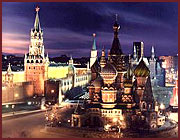 Across
the vast land of Russia are scattered a numerous number of
large cities and small towns where legendary buildings are
dating back from the long past. Although much of the invaluable
property of the country has been lost, there still remain
more than forty thousand officially-recorded historic sites.
These historic places vividly demonstrate architectural talents
of Russians. The historic, architectural and artistic heritage
is the glory and pride of Russia. Across
the vast land of Russia are scattered a numerous number of
large cities and small towns where legendary buildings are
dating back from the long past. Although much of the invaluable
property of the country has been lost, there still remain
more than forty thousand officially-recorded historic sites.
These historic places vividly demonstrate architectural talents
of Russians. The historic, architectural and artistic heritage
is the glory and pride of Russia.
For most of its history, Russian architecture has been predominantly
religious. Russia's most characteristic architectural
feature is its onion-domed churches, which evolved when the
wooden churches of the north were translated into brick and
colourful tilework. Churches were for centuries the only buildings
to be constructed of stone, and today they are almost the
only buildings that remain from its ancient past. The basic
elements of Russian church design emerged fairly early, around
the eleventh century.
Only a few places in the world are destined to become
a kind of symbol. One of them is Red Square in Moscow,
a symbol of great emotive power. Although the square itself
is not very big (695 metres long and 130 metres wide), it
impresses one by the richness and variety of its forms which
merge in austere harmony. The ensemble is dominated by the
Kremlin and the Lenin Mausoleum
which stands by its walls. The powerful tent roofs of the
Saviour and St. Nicholas towers emphasize the key position
of this memorial which links the old ensemble with the present
day.
Kremlin is the Russian word for citadel, and that's
exactly what the Moscow Kremlin was: a medieval walled city
on a hill above the Moscow River. Long ago, of course, the
city grew far beyond the walls, but the citadel remained the
seat of a government.
For the last eight centuries the Moscow Kremlin (or
Kremle) was the witness of many glorious and tragicevents
of our history. There are explosions of hostile guns, celebration
of holidays and boiling ofriots near the Kremlin walls. Now
the Moscow Kremlin is one of the greatest museums of the world.The
Kremlin palaces and chambers are keeping the state regalia,
invaluable icons and treasures of the tsars.
|
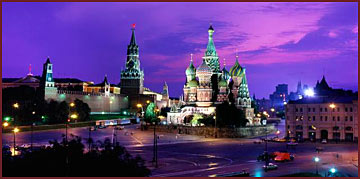
View of the Red Square: Saviour Tower
and Intercession Cathedral.
As ancient chronicles assert, the Red Square appeared
at the end of 15th century, when Ivan III ordered to ruin all
wooden buildings, surrounding the Kremlin and threatening with
the fire, and to allot this area for a market.
In Russia the same object might have several names. Thus,
The Red Square was officially given its modern name in 19th
century, though the name was mentioned in the documents of 17th
century. Different centuries left their traces:15th century
gave the Kremlin's Wall with Spasskaya, Senatskaya and Nikolskaya
towers; 16th - Place of execution. (Lobnoe mesto), and the Cathedral
of Vasily the Blessed; 19th century - the monument to Minin
and Pozharsky, the building of Historical museum and Upper Trade
Rows (GUM), 20th century - Lenin's
Mausoleum.
|
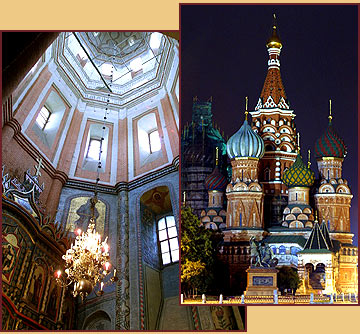
The word "red" doesn't refer to the color of
the bricks or to Communism. In Russian, the square is called
"Krasnaya Ploschad". The word "krasnaya"
means both "red" and "beautiful," and the
latter, referring to St. Basil's Cathedral at the southern end
of the square, was the original meaning. St. Basil's is once
again being used for religious services, but one can still tour
the inside, where the walls are decorated with antique icons.
|
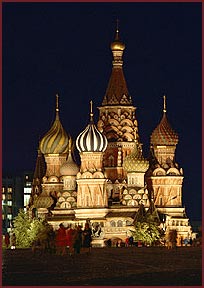 The
most famous and important of the old Russia'a memorial buildings,
the Intercession Cathedral (also called the Cathedral of St.
Basil the Blessed) was erected in 1555-61 to commemorate the
great Russian conquest of the Khanate of Kazan. It was a kind
of memorial to all those who had perished in the long struggle
to liberate the Russian land from foreign overlordship. And
it was built by two fine self-taught masters, Postnik and Barma.This
"fairy-tale in stone" has delighted people with its
unique forms and colours. Before the extra tiers were added
to the Ivan the Great Bell-Tower, the Intercession Cathedral
was the tallest building in Moscow (65 metres). The
most famous and important of the old Russia'a memorial buildings,
the Intercession Cathedral (also called the Cathedral of St.
Basil the Blessed) was erected in 1555-61 to commemorate the
great Russian conquest of the Khanate of Kazan. It was a kind
of memorial to all those who had perished in the long struggle
to liberate the Russian land from foreign overlordship. And
it was built by two fine self-taught masters, Postnik and Barma.This
"fairy-tale in stone" has delighted people with its
unique forms and colours. Before the extra tiers were added
to the Ivan the Great Bell-Tower, the Intercession Cathedral
was the tallest building in Moscow (65 metres).
|
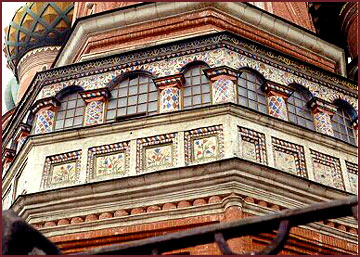 Kremlin. Close-up of the Intercession
Cathedral.
Kremlin. Close-up of the Intercession
Cathedral.
For more than four centuries this remarkable edifice
has survived numerous fires, natural disasters and enemy invasions
to delight and astound all who look upon it.
Once the courage of the architect and devotee of Russian culture,
P. Baranovsky, saved the church. When ordered to prepare the
cathedral for destruction he refused and threatened to cut his
own throat on the steps of the church, then sent a bluntly worded
telegram to the leader of the party himself relating the above.
For some reason Stalin cancelled
the decision to knock the church down and for his efforts Baranovsky
was rewarded with five years in jail.
|
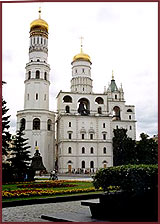 The Ivan the Great Bell Tower is the
tallest structure in the Kremlin (81 m or 266 ft). It was built
in 1505-08. From the top of the tower, the view extends for
some 40 km (25 miles), so it was a strategic watch tower. There
are 329 steps to the top. The Bell Tower and belfry still carry
21 bells which are remarkable creations of Russian foundry art.
When retreating from Moscow in 1812, Napoleon
ordered the Bell Tower of Ivan the Great to be blown up, but
the magnificent structure withstood the blast and only the contiguous
belfries were destroyed. In 1814-1815, the entire ensemble was
restored. The Ivan the Great Bell Tower is the
tallest structure in the Kremlin (81 m or 266 ft). It was built
in 1505-08. From the top of the tower, the view extends for
some 40 km (25 miles), so it was a strategic watch tower. There
are 329 steps to the top. The Bell Tower and belfry still carry
21 bells which are remarkable creations of Russian foundry art.
When retreating from Moscow in 1812, Napoleon
ordered the Bell Tower of Ivan the Great to be blown up, but
the magnificent structure withstood the blast and only the contiguous
belfries were destroyed. In 1814-1815, the entire ensemble was
restored.
|
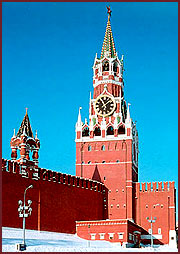 The
70 m (230 ft) high Saviour Tower is the most magnificent of
the Kremlin towers, the very symbol and emblem of Moscow. From
time immemorial it has been thep rincipal entrance to the Kremlin.
The tower was given its name in 1658, when an iconof Christ
was set up over the entrance. Before the October
Revolution, men were required to take their hats off when
passing through the gate. The
70 m (230 ft) high Saviour Tower is the most magnificent of
the Kremlin towers, the very symbol and emblem of Moscow. From
time immemorial it has been thep rincipal entrance to the Kremlin.
The tower was given its name in 1658, when an iconof Christ
was set up over the entrance. Before the October
Revolution, men were required to take their hats off when
passing through the gate.
|
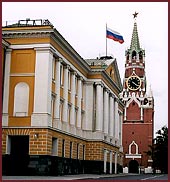 The
first clock was set into the tower in the 16th century. Subsequently,
the clock'smechanism has been changed repeatedly. Thegigantic
mechanism (about 25 tons) of the carillon occupies three storeys
of the tower. Until the October Revolution the carillon played
the tsaristnational anthem, and between 1917 and 1941 it played
the "Internationale".The clock now only strikes the
hours. The ruby star was installed in 1937. The
first clock was set into the tower in the 16th century. Subsequently,
the clock'smechanism has been changed repeatedly. Thegigantic
mechanism (about 25 tons) of the carillon occupies three storeys
of the tower. Until the October Revolution the carillon played
the tsaristnational anthem, and between 1917 and 1941 it played
the "Internationale".The clock now only strikes the
hours. The ruby star was installed in 1937.
|
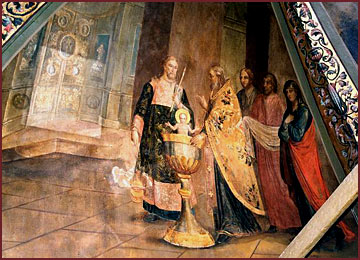 Kremlin. This icon is painted on the
ceiling of South Galery of The Cathedral of the Annunciation.
Kremlin. This icon is painted on the
ceiling of South Galery of The Cathedral of the Annunciation.
|
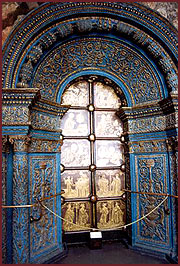 The
Cathedral of the Annunciation, with its nine gilded domes, is
the smallest of the three main Kremlin cathedrals, but the decoration
of the interior (in particular the frescoes and icons by Andrei
Rublev and Feofan Grek) makesit one of the great treasures of
Moscow. The cathedral was built in 1484-89 by a team of buildersfrom
Pskov as the court church of Grand Prince Ivan III. It was connected
by a passage at the gallery level with the palace of the grand
prince and laterwith the tsar's residence. The passage still
leads from the gallery into the Great Kremlin Palace, which
immediately adjoins the cathedral. The
Cathedral of the Annunciation, with its nine gilded domes, is
the smallest of the three main Kremlin cathedrals, but the decoration
of the interior (in particular the frescoes and icons by Andrei
Rublev and Feofan Grek) makesit one of the great treasures of
Moscow. The cathedral was built in 1484-89 by a team of buildersfrom
Pskov as the court church of Grand Prince Ivan III. It was connected
by a passage at the gallery level with the palace of the grand
prince and laterwith the tsar's residence. The passage still
leads from the gallery into the Great Kremlin Palace, which
immediately adjoins the cathedral.
|
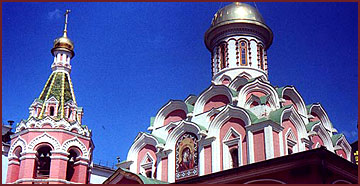
The Kazan Cathedral, August 2002
The original Kazan Cathedral was built in 1636 in honor
of the Kazanskaya Icon and to commemorate Tsar Mikhail Romanov's
victory over the Poles and Lithuanians in 1612. The Kazanskaya
Icon is one of the city's most precious icons and was discovered
by a 9-year-old girl, to whom legend has it the Virgin Mary
appeared three times in dreams to tell her of the miracle-working
icon's location.
|
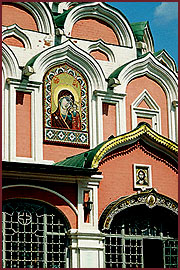 Unfortunately,
like most of the churches in Moscow, Kazan Cathedral was destroyed
by the Bolsheviks, ironically on the very same day in 1936 that
the church was meant to celebrate its 300th anniversary. If
it has not been for the courageous efforts of the architect
Baranovsky, who was also responsible for saving St. Basil's
Cathedral from destruction and who made secret plans of Kazan
Cathedral even as the building was being torn down, there would
be no replica standing on the site today. Once the church had
been demolished, various structures were erected on the site,
including a street cafe and a public washroom. In November 1990
the Orthodox Patriarch Alexy II laid the cathedral's foundation
stone and three years later, re-consecrated the newly built
church. Unfortunately,
like most of the churches in Moscow, Kazan Cathedral was destroyed
by the Bolsheviks, ironically on the very same day in 1936 that
the church was meant to celebrate its 300th anniversary. If
it has not been for the courageous efforts of the architect
Baranovsky, who was also responsible for saving St. Basil's
Cathedral from destruction and who made secret plans of Kazan
Cathedral even as the building was being torn down, there would
be no replica standing on the site today. Once the church had
been demolished, various structures were erected on the site,
including a street cafe and a public washroom. In November 1990
the Orthodox Patriarch Alexy II laid the cathedral's foundation
stone and three years later, re-consecrated the newly built
church.
|
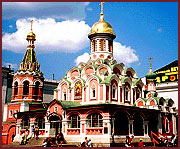 Today,
Kazan Cathedral boasts a pink and white exterior replete with
the ornate window frames and gables characteristic of early
Muscovite church architecture, and crowned by a cluster of green
and gold domes. The church was re-opened on November 4th 1993
on the celebration day of the Icon of Kazan and has been hosting
regular services ever since. Today,
Kazan Cathedral boasts a pink and white exterior replete with
the ornate window frames and gables characteristic of early
Muscovite church architecture, and crowned by a cluster of green
and gold domes. The church was re-opened on November 4th 1993
on the celebration day of the Icon of Kazan and has been hosting
regular services ever since.
The history of the State Repository of Values (Gokhran)
- the vaults beneath the Kremlin, the country's biggest state
secret. The secret was thoroughly guarded for more than 70 years.
All Gokhran's documents were strictly classified. No more than
10 persons knew the exact amount of values kept in Gokhran.
The history of creation of Gokhran was kept secret too - it
incorporates too much human tragedy and drama.

|

|
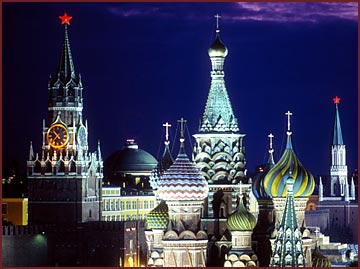
|
Kremlin.
Saviour Tower and Intercession Cathedral.
|

|
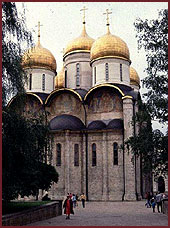 The Uspensky Sobor, or the Cathedral of
the Dormition of the Virgin, (sometimes called the Assumption
Cathedral), is the largest and the most historic of the cathedrals
in the Kremlin. Here princes, grand princes and tsars were crowned
by the metropolitan or patriarch; here metropolitans and patriarchs
were enthroned and buried, and here many a chapter in the history
of Moscow and of Russia began or was concluded. The Uspensky Sobor, or the Cathedral of
the Dormition of the Virgin, (sometimes called the Assumption
Cathedral), is the largest and the most historic of the cathedrals
in the Kremlin. Here princes, grand princes and tsars were crowned
by the metropolitan or patriarch; here metropolitans and patriarchs
were enthroned and buried, and here many a chapter in the history
of Moscow and of Russia began or was concluded.
|
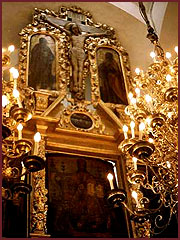 Built
during 1158 - 1479, Assumption Cathedral combined traditional
Russian Orthodox building techniques with ideas from the Italian
Renaissance. The Cathedral of the Assumption is still the dominant
part of the city's skyline. Standing on the steep left bank
of the river, the cathedral is visible from a great distance
to anyone coming from Murom. Up to four thousand people could
gather inside it. Built
during 1158 - 1479, Assumption Cathedral combined traditional
Russian Orthodox building techniques with ideas from the Italian
Renaissance. The Cathedral of the Assumption is still the dominant
part of the city's skyline. Standing on the steep left bank
of the river, the cathedral is visible from a great distance
to anyone coming from Murom. Up to four thousand people could
gather inside it. |
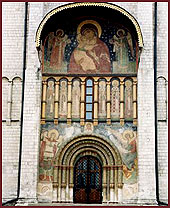 At
door level are the icon of the Savior with the fiery or severe
eye (14thc.), the Dormition of the Virgin, and a copy of the
old testament Trinity. To the left of the Royal Door is a copy
of the revered Vladimir Icon of the Mother of God. At
door level are the icon of the Savior with the fiery or severe
eye (14thc.), the Dormition of the Virgin, and a copy of the
old testament Trinity. To the left of the Royal Door is a copy
of the revered Vladimir Icon of the Mother of God.
In 1812 the cathedral was occupied by Napoleon's Army,
who used some of the icons for firewood, and tried to carry
off some 250 kg (550 pounds) of gold and five tons of silver.
Most of it was abandoned during their retreat and was recovered
and returned to the cathedral.
|
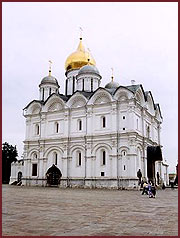 The
Archangel Cathedral, built in 1505-08 by Alevis Novi, was the
burial church of the tsars. Here all the Russian princes, grandprinces
and tsars from Ivan Kalita onwards had their last resting-place. The
Archangel Cathedral, built in 1505-08 by Alevis Novi, was the
burial church of the tsars. Here all the Russian princes, grandprinces
and tsars from Ivan Kalita onwards had their last resting-place.
Unlike the other Kremlin cathedrals, the Cathedral of the Archangel
has silver domes, apart from the recently gilded central dome.
|
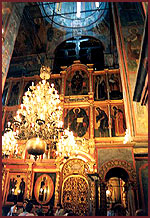 Though built at the eginning of the 16th century, the Archangel
Cathedral was painted only in the second half of that century.
Though built at the eginning of the 16th century, the Archangel
Cathedral was painted only in the second half of that century.
Only part of this painting has survived - in the altar
and on the west portal. In 1652-66, a large team of artists
from Yaroslavl, Kostroma, and Vologda painted the cathedral's
frescoes, repeating the motifs of the sixteenth century painting.
|
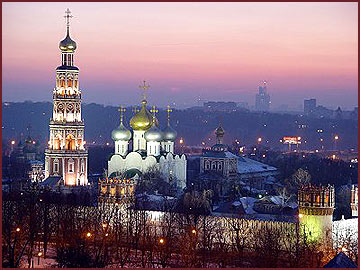
Kremlin. View of the Archangel Cathedral.
|
| The
Arsenal was built between 1702 and 1736, with some interruptions
in the work. The general plan of the building was sketched out
by Peter the Great himself;
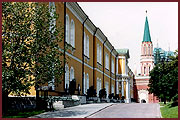 The
Arsenal was partly destroyed by fire in 1737, and was reconstructed
in 1786-96 by the engineer Gerard. It was given its present
aspect between 1815 and 1828, after the French attempts to
blow up the Kremlin before abandoning Moscow made radical
rebuilding necessary. The
Arsenal was partly destroyed by fire in 1737, and was reconstructed
in 1786-96 by the engineer Gerard. It was given its present
aspect between 1815 and 1828, after the French attempts to
blow up the Kremlin before abandoning Moscow made radical
rebuilding necessary.
|
After
the rebuilding it was intended that the Arsenal would be used
as an army museum: hence the 875 cannon lining the outside walls.
The stucco reliefs of military trophies on the walls reflect
the same intention.
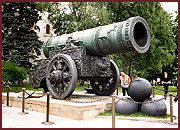 The
Tsar Cannon is an interesting specimen of sixteenth century
foundry work. It was cast of bronze in 1586 by the Russian master
Andrei Shchokhov. It weighs nearly 40 tons and has a barrel
5.34 m (17 ft) long and a bore of 890 mm (35 in). This is
the largest bore of any cannon in the world. The cannon
balls weigh a ton each. The
Tsar Cannon is an interesting specimen of sixteenth century
foundry work. It was cast of bronze in 1586 by the Russian master
Andrei Shchokhov. It weighs nearly 40 tons and has a barrel
5.34 m (17 ft) long and a bore of 890 mm (35 in). This is
the largest bore of any cannon in the world. The cannon
balls weigh a ton each.
|
|
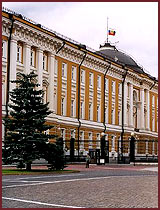 Opposite
the Arsenal, on the edge of Senate Square, stands the imposing
Neoclassical Senate building. Opposite
the Arsenal, on the edge of Senate Square, stands the imposing
Neoclassical Senate building.
The building was commissioned by Empress Catherine the Great
to house meetings of the Moscow branch of the Senate, an advisory
body that she had set up in 1711, and has been the official
residence of the Russian President since 1991. After its construction,
the commandant of the Kremlin doubted the stability of the
building's large green dome, which is clearly visible from
Red Square, and the architect was forced to climb up onto
the cupola and stay there for more than an hour before he
was convinced of its integrity. The cupola sits above the
building's impressive grand hall, which was used formerly
for meetings of the USSR Council of Ministers.
The building also used to contain the former quarters
of Lenin and Stalin's
study, under which a secret passage was discovered that may
have enabled the Director of the Secret Police, Beria, to
overhear the dictator's conversations. The Senate Building
looks onto Senate Square, where in February 1905 the terrorist
Ivan Kalyaev, a member of the Socialist Revolutionary Party,
threw a bomb at the carriage in which the uncle of Tsar
Nicholas II, Grand Duke Sergei Alexandrovich, was traveling.
|
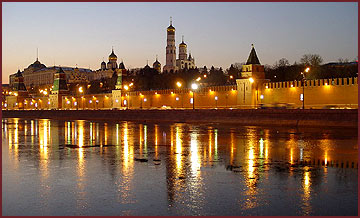
Walls of Kremlin. View of the Moscow
River.
|
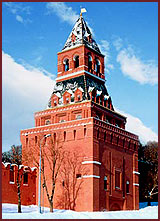 The
Konstantino-Yeleninskaya Tower served as the Kremlin torture
chamber in medieval times and stands on the site of the
white-stone Timofeyev Tower, through whose gates Dmitry Donskoy
led his troops in 1380 to the historic battle of Kulikovo against
the Mongol and Tartar armies. The
Konstantino-Yeleninskaya Tower served as the Kremlin torture
chamber in medieval times and stands on the site of the
white-stone Timofeyev Tower, through whose gates Dmitry Donskoy
led his troops in 1380 to the historic battle of Kulikovo against
the Mongol and Tartar armies.
The Lobnoye Mesto, a circular stone platform on Red Square
not far from St. Basil's Cathedral, was built in the early 16th
century and used primarily as a platform from which the Tsar's
edicts were read out, special church sermons were given and
the sentences of convicted criminals were aired. The platform's
name derives from its location, on a steep slope or "uzlobie"
in Russian. In Orthodox Moscow this place symbolized the hill
of Golgotha in Jerusalem, on which Christ was crucified. In
translation from the ancient Hebrew Golgotha means "lob",
head or forehead, hence the connection.
|
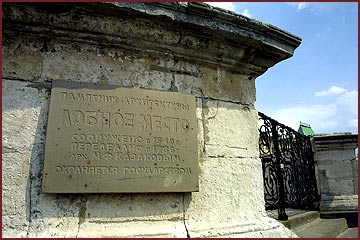 |
Raised
platform (Lobnoe Mesto) in Red Square once used for public executions.
Lobnoye Mesto was also a place where holy relics were
displayed so that the people of Moscow could honor them, where
the boyars Boris Godunov and Vasily Shuisky were proclaimed
Tsar and where the heir to the throne was traditionally carried
on his 14th birthday, so that the people could see their future
Tsar and not allow an impostor to assume the throne. The platform
was also the site from which Ivan the Terrible begged for the
peoples' forgiveness in 1547, after Moscow was almost completely
destroyed by a fire that the Patriarch of the Orthodox Church
pronounced to be God's punishment for his barbaric actions.
It is a common misconception that the Lobnoye Mesto was the
square's execution site, but most executions were in fact carried
out on the slope behind St. Basil's. |
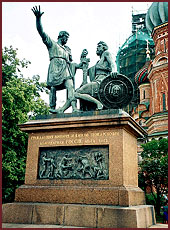 In
the small garden outside St. Basil's stands an impressive bronze
Statue to Minin and Pozharsky, who rallied Russia's volunteer
army during the Time of Troubles and drove out the invading
Polish forces. In
the small garden outside St. Basil's stands an impressive bronze
Statue to Minin and Pozharsky, who rallied Russia's volunteer
army during the Time of Troubles and drove out the invading
Polish forces.
They were an interesting duo - Dmitry Pozharsky was a
prince, while Kuzma Minin was a butcher from Nizhny Novgorod.
|
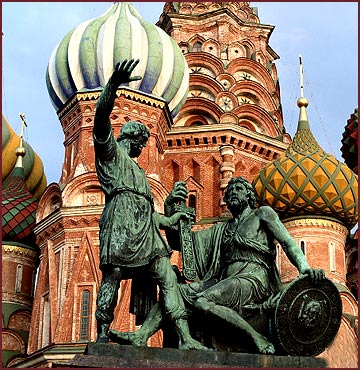
For more information about Moscow Kremlin please check their
official website.
(English version of this site will be available soon)
|
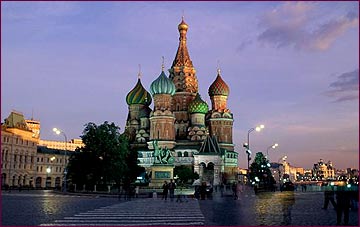 |
|


